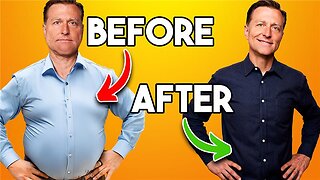Premium Only Content

Ketogenic Diet: Macronutrients Confusion When Doing Keto & Intermittent Fasting Dr.Berg
I know how confusing keto macros can be!
Timestamps:
0:00 Keto macros can be confusing, but I’ll clarify them
4:58 Even when reducing your number of meals, keep the grams of carbs the same
5:58 Ratio your amount of protein depending on how many meals you consume
6:36 The amount of fat is the wild card!
People get confused about keto macros on a ketogenic diet and intermittent fasting plan. Here’s what I mean by keto macros: the percentages of carbohydrates, proteins, and fats. You might feel confused when I start explaining, but watch until the end; I’ll clear it up.
Keto macros are given as five percent carbs, twenty percent proteins, and seventy five percent fats. When we add in intermittent fasting, this confuses everything because you go from three meals per day, to two, to one. The percentages change.
Let’s say you eat 1,800 calories total calories on three meals per day; 1,500 on two meals; 1,200 on one. Calories reduce somewhat of their own accord, the fewer meals per day you eat. As you reduce the frequency of your eating, you retain more nutrients from the amount of food you eat. The percentages of keto macros then change. Plus, it’s really hard to consume 1,800 calories in just one healthy keto meal per day!
Ideally, on three meals a day, you should have a total per day of ten cups of vegetables. You can divide the ten cups by three meals for your amount per meal. When you go to two meals per day, your body is more efficient, so you can reduce the vegetables to eight cups per day or four cups per meal. When you get to one meal per day, you’d eat a total of seven cups of vegetables. As you reduce your number of meals, your body metabolically adapts and holds more nutrients from each meal.
If you can keep your carbs to twenty or fewer grams per day, that would be ideal, and this applies whether you’re consuming three, two, or one meal per day. It’s the total grams of carbs that are important. Thirty grams or fewer is acceptable; twenty is ideal.
For protein, aim for four ounces per meal if you’re consuming three meals per day; five per meal if two meals per day; eight ounces for one meal per day.
As for fat, when you first start keto and intermittent fasting, you’re going to need more fat. As you progress, you’ll need to consume less fat because your body is eating its own fat. The best way to judge how much fat you need is based on your hunger. Eat enough fat to keep you comfortable full between meals but not so much that you feel stuffed. On average, you’d consume 140 grams per day if you’re consuming three meals; 113 grams if two meals; 86 grams if eating one meal per day.
The meal plans on my website, under Recipes, already have these keto macro amounts built into them.
Talk to a Product Advisor to find the best product for you!
Call 1-540-299-1556 with your questions about Dr. Berg's products. Product Advisors are available Monday through Friday 8am-6pm and Saturday 9am-5pm EST.
* At this time, we no longer offer Keto Consulting and our Product Advisors will only be advising on which product is best for you and advise on how to take them.
Dr. Eric Berg DC Bio:
Dr. Berg, age 56, is a chiropractor who specializes in Healthy Ketosis & Intermittent Fasting. He is the author of the best-selling book The Healthy Keto Plan, and is the Director of Dr. Berg Nutritionals. He no longer practices, but focuses on health education through social media.
Follow Me On Social Media:
Facebook: https://bit.ly/FB-DrBerg
Instagram: https://bit.ly/IG-DrBerg
Anchor: https://bit.ly/Anchor-DrBerg
TikTok: https://bit.ly/TikTok-DrBerg
DR. BERG'S SHOP: http://shop.drberg.com/
Send a Message to his team: https://m.me/DrEricBerg
ABOUT DR. BERG: https://www.drberg.com/dr-eric-berg/bio
Disclaimer:
Dr. Eric Berg received his Doctor of Chiropractic degree from Palmer College of Chiropractic in 1988. His use of “doctor” or “Dr.” in relation to himself solely refers to that degree. Dr. Berg is a licensed chiropractor in Virginia, California, and Louisiana, but he no longer practices chiropractic in any state and does not see patients so he can focus on educating people as a full time activity, yet he maintains an active license. This video is for general informational purposes only. It should not be used to self-diagnose and it is not a substitute for a medical exam, cure, treatment, diagnosis, and prescription or recommendation. It does not create a doctor-patient relationship between Dr. Berg and you. You should not make any change in your health regimen or diet before first consulting a physician and obtaining a medical exam, diagnosis, and recommendation. Always seek the advice of a physician or other qualified health provider with any questions you may have regarding a medical condition.
Thanks for watching!
Keto macros can be really confusing!
-
 7:06
7:06
Dr. Eric Berg
1 day agoThe #1 Breakfast Mistake That Almost Killed Me
4.22K6 -
 LIVE
LIVE
Cancel This Podcast
6 hours ago $0.57 earnedROLE-PLAYING GRINDS: FINAL FANTASY XIV, DRAGON QUEST X & OCTOPATH COTC - CTP GAMING MONDAYS!
306 watching -
 7:25:37
7:25:37
FoeDubb
7 hours ago🏰KINGDOM MENU :🎮LATE NITE PUBG 🤣MOST LIKELY A BAD IDEA DILLY DILLY!!!
11.2K -
 1:34:52
1:34:52
Glenn Greenwald
9 hours agoIs There Evidence of Epstein's Ties to Israel? Yes: Ample. Brazil's Chief Censor Orders Rumble to Ban US Citizen and Turn Over Data | SYSTEM UPDATE #486
151K130 -
 2:20:40
2:20:40
GamerGril
3 hours agoMarvel Rivals Monday | Battle Of The Bronze
10.6K3 -
 46:08
46:08
FanatikGaming
2 hours ago $0.71 earned💪Monday Motivation🦾 - Legends Never DIE!💯💯 ATWU - BTTB!☝️🔥
14.8K2 -
 LIVE
LIVE
WolfLinksShadow
3 hours agoMario Kart Monday & More!
195 watching -
 58:16
58:16
Redacted News
11 hours agoThe Secret Space Program IS REAL and this Whistleblower is EXPOSING all of it
79K260 -
 3:37:54
3:37:54
This is the Ray Gaming
4 hours ago $0.44 earnedHead Shots and Heart Breaks | Rumble Premium Creator
11.4K1 -
 3:45:47
3:45:47
tangodelta
5 hours agoGray Zone Warfare - Lamang Real Estate
13.6K1